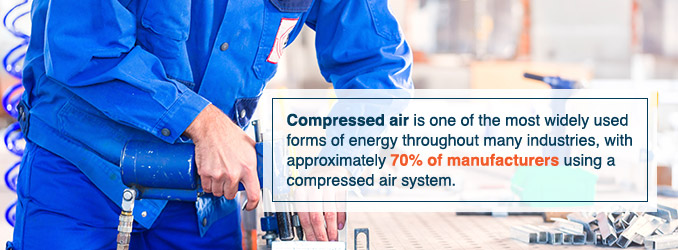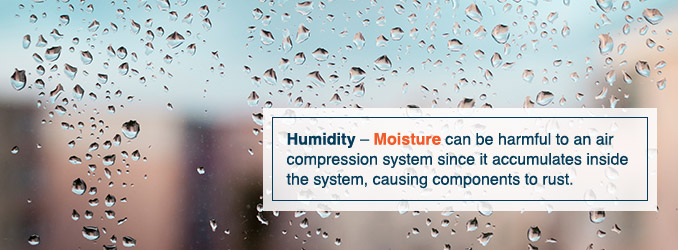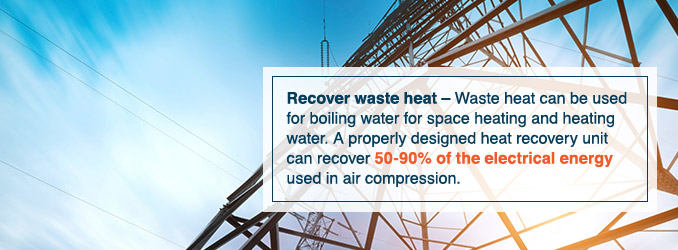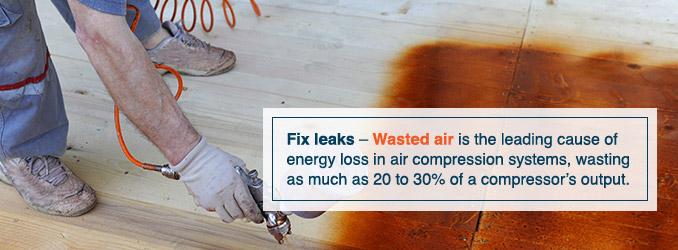Table of Contents
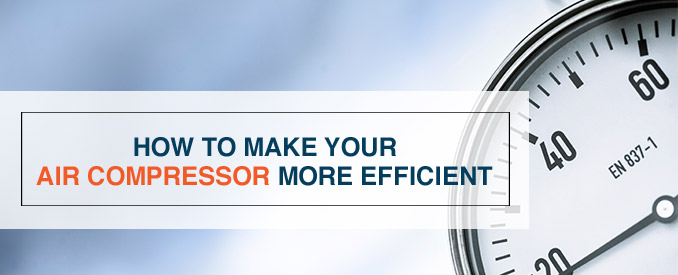
Many industries use compressed air systems to power tools and complete tasks. However, compressed air uses a significant amount of energy, resulting in higher costs for manufacturing plants. One horsepower of compressed air requires 8 horsepower of electricity. If systems run at limited efficiency, facilities might use more energy than they need for daily operations.
Optimizing compressed air efficiency allows your organization to gain the most benefits for your expenses. Learn more about what impacts compressed air efficiency and how you can improve system productivity.
What Factors Affect Air Compressor Efficiency?
Various factors impact air compressor efficiency, including air compressor traits like:
- Type
- Model
- Size
- Motor power rating
- System design
- Control mechanisms
- Uses
- Maintenance schedule
You should examine the entire system to measure efficiency, which includes supply lines, air storage tanks, air dryers, receivers and after-coolers. By making the right adjustments to your compressed air system, you can save significant amounts of energy and money.
What Causes Air Compressor Inefficiency?
Many factors can contribute to an air compressor’s inefficiency. The chief reason for inefficient air compression is the loss of heat generated from the increased temperature of pressurized air and from friction caused by the system’s many moving parts.
Air compressor performance may grow less efficient due to causes like:
- Poor quality air intake: An air compressor’s efficiency can reduce significantly if the incoming air is too hot, contains impurities or has high humidity.
- Inconsistent air pressure controls: The air compressor controls deliver an inconsistent or sustained high pressure. When air compressors run closer to the maximum pressure, they can put increased strain on the system and reduce efficiency.
- Design system flaws: Flaws in the system design can decrease air compressor efficiency. Design errors may include an improperly sized distribution system, lack of recovery system and increased heat waste, unnecessary bends in the pipes and unfixed leaks.
- Mismatched air compressor: When air compressors are mismatched to the application, the compressors’ efficiency and overall performance are significantly reduced.
- Decreased pressure: Pressure drops in your air compressor system can have a noticeable impact on your air compressor’s efficiency. A pressure drop may occur from improperly sized pipes, excess moisture, dirty filters or long air travel distances.
- Irregular maintenance: Inconsistent maintenance will cause the system to wear prematurely and increase repair expenses. Due to the number of moving parts and the heavy usage of these systems, failure to set a regular maintenance schedule can make air compressors inefficient.
How to Maximize Compressor Efficiency
You can take many approaches to improve compressor efficiency. A crucial first step is to determine what factors are limiting performance. Energy-efficient compressors depend on both the controls and the design to provide maximum efficiency.
Efficient air compressor systems require properly tuned controls that run closer to the minimum pressure and a well-maintained system design that matches the application.
Improve your system’s efficiency with the following approaches:
Contact Us Learn More Find a Dealer Near You
1. Improve the Quality of the Air Intake
Air quality affects how your system functions. Three components of the air compression system influence performance:
- Temperature: The temperature of the intake air determines air density. Cool air requires less energy to compress, making it far more efficient to pump into the air compressor system. Avoid using hot air, which has a lower density, as it can significantly reduce your productivity.
- Composition: Clean intake air ensures that compressed air can move more smoothly through the system. Dirt, dust or other impurities in the air will accumulate inside an air compressor. These contaminants can build up on vital parts and cause wear and reduced storage capacity. You can improve composition with regular maintenance and cleaning.
- Humidity: Moisture can be harmful to an air compression system when it accumulates inside the system, causing components to rust. This may lead to wear, leaks and reduced storage capacity. Dry air is less likely to damage your air compression system and tools performing work at the point of use. To reduce humidity, use your compressed air system only in dry environments.
2. Match the Air Compressor Controls
Air compressor controls match the compressor output with the demands of the compressor system, which can consist of a single compressor or multiple compressors. These controls are essential for air compressor system efficiency and high performance.
Compressed air systems are designed to maintain a certain range of pressure and to deliver a volume of air that varies with end-user demands. The control system decreases compressor output when the pressure reaches a certain level. If pressure drops, on the other hand, compressor output is increased.
The most precise control systems can maintain low average pressure without falling below system requirements. Falling below system requirements may cause equipment to malfunction, making it essential to match system controls with storage capacity.
The following controls can help increase the efficiency of single compressors:
- Start and stop controls turn compressors on and off depending on pressure.
- Load and unload functions unload the compressor to discharge pressure.
- Modulating controls manage flow needs, while multistep controls allow compressors to operate at partially loaded conditions.
- Dual-Control and Auto-Dual controls allow the selection of either start/stop or load/unload.
- Variable displacement can operate in two or more partially loaded conditions.
- Variable speed drives continuously adjust drive motor speed to meet variable demand requirements.
- Systems with multiple compressors use system master controls to coordinate all the functions necessary to optimize compressed air.
- System master controls can coordinate compressed air systems when complexity exceeds the capabilities of local and network controls. Such controls can monitor system components and trend data to enhance maintenance functions.
- Pressure and flow controllers store higher-pressure air, which you can use later to meet changes in demand.
A well-designed system should use the following:
- Demand control
- Storage
- Compressor controls
- Strong signal locations
- Overall control strategy
The primary goal of such a system is to deliver compressed air at the lowest stable pressure while supporting fluctuation with stored higher-pressure compressed air.
For multiple compressors, sequencing controls can meet demand by running compressors to meet system loads while taking them offline when not needed. Network controls also help manage loads for the entire system.
3. Improve System Design
Changing your system design can also enhance air compressor performance. Here are six ways to improve the design:
- Straighten the path: Narrow delivery lines or sharp bends in those delivery lines can cause increased friction and pressure drops in the system, which means less pressure reaching the point of use. A better design without so many bends and loops should produce more pressure using the same energy.
- Save energy: A storage tank, or receiver, can buffer short-term demand changes and reduce on and off cycling. A tank can also prevent system pressure from dropping below minimum pressure requirements when demand is at its highest. A pressure drop may cause the system pressure to increase, resulting in wasted air pressure. Tanks are sized depending on the power of the compressor. For example, a 50-horsepower air compressor needs a 50-gallon air receiver tank.
- Cool the intake air: Since the energy needed to compress cool air is less than the energy needed to compress warmer air, you can reduce the energy required for compression by moving the compressor intake into a shaded area outside. A reduction of 20 degrees Fahrenheit, for example, can lower operating costs by almost 3.8%.
- Use several small compressors: Oversized air compressors can be very inefficient because they use more energy per unit while operating with a partial load. Such systems may benefit from the use of many smaller compressors with sequencing controls, permitting portions of the system to be shut down merely by turning off some of the compressors.
- Recover waste heat: Waste heat can be used for boiling water for space heating and heating water. A properly designed heat recovery unit can recover 50-90% of the electrical energy used in air compression.
- Locate it near areas of high demand: By locating air receivers near sources of high demand, it’s easier to meet demand with reduced overall compressor capacity.
4. Consider Compressed Air Needs
Thorough inspections allow you to evaluate air compressor needs more closely. Below are a few aspects to inspect when you encounter inefficiencies:
- Examine the load profile: A properly designed compressed air system should consider the load profile. If there are wide variations in air demand, the system will need to work efficiently when it’s under part load. Multiple compressors will provide more economical energy use when there are large fluctuations in demand.
- Minimize artificial demand: Artificial demand is the excess air volume required for unregulated use when using higher pressure than necessary for applications. If an application requires 50 psi and receives 90 psi, the system is producing unused air. Pressure regulators at the end-use can minimize artificial demand.
- Determine the necessary pressure: Required pressure levels must consider system losses from filters, piping, separators and dryers. Raising discharge pressure will increase the demand for unregulated usages, such as leaks. In other words, pressure increases will generate increased inefficiency. For example, a 2-psi increase in header pressure will increase energy consumption by as much as 1% because of the consumption of unregulated air. To save energy, you should consider how to achieve high performance while reducing system pressure.
- Examine proper supply and demand: Verify that air compressors are not too large for end-use. Consider all end-use, quantifying the volume of air needed for each application. A general assessment of your entire compressed air system should help investigate the distribution system for problems and minimize inappropriate uses of air.
- Use block diagrams and pressure profiles: Block diagrams will help identify all components in an air compression system. A pressure profile reveals the pressure drops in the system, which should provide feedback for adjusting controls. To complete a pressure profile, you’ll need to take measurements of the inlet to the compressor, the differential across the air/lubricant separator and the interstage on multi-stage compressors. By data logging system pressures and airflow, you can determine system disruptions, intermittent loads, system changes and general conditions. Variations in pressure and airflow can be managed with system controls to minimize the impact on production.
- Use compressed air storage: Storage can control demand events during demand peaks by reducing the rate of decay and the amount of pressure drop. It can also protect critical operations from other events in the system by turning off a compressor if necessary.
5. Minimize Pressure Drop
Pressure drops occur as compressed air travels through the distribution system. Excessive pressure drops may cause poor performance and elevated energy consumption. Pressure drops upstream from the compressor signal result in lower operating pressure for the end user.
Before adding capacity or increasing system pressure, be sure to reduce pressure drops in the system. You should operate compressed air equipment at the lowest efficient operating pressure for the best results.
These tips are a few ways to reduce pressure drops:
- Maintain proper system design: The most common reason for excessive pressure drop is the use of inadequate pipe size between the distribution header and the production equipment. This can happen if you choose piping based on the expected average compressed air demand without considering the maximum flow rate.
- Minimize moisture: Maintain air filtering and drying equipment to reduce moisture.
- Replace and clean filters: Ensure filters are free of dirt that restricts airflow and causes pressure drops. Timely maintenance and replacement of filter elements are critical to reducing pressure drop.
- Select components with the lowest pressure differences: Choose separators, dryers, filters and aftercoolers with the lowest possible pressure drop. A typical pressure differential for a filter, hose and pressure regulator is 7 pounds per square inch differential (psid).
- Reduce air travel distance: Reduce the distance air travels through the compressed air system.
Many tools can operate effectively with an air supply of 80 pounds per square inch gauge (psig) or less. By reducing the air compressor discharge pressure, you can reduce leakage rates, improve capacity and save money. However, reductions in operating pressure may require modifications to pressure regulators, filters and storage size. Keep in mind that if system pressure falls below minimum requirements, equipment may no longer function properly.
Reducing pressure drops allows a system to operate more efficiently at lower pressures. For machinery that uses large amounts of compressed air, operating the equipment at lower pressure levels can provide significant energy savings. Components like larger air cylinders may be necessary to maintain proper functionality at lower pressure levels, but the energy savings should exceed the cost of additional equipment.
Compressor Maintenance
Another essential factor of compressor efficiency is maintenance. Poorly maintained air compression systems can waste energy and money. To avoid wasted expenses, you should constantly check your systems for leaks, premature wear and tear and the accumulation of contaminants.
Implement a maintenance program for compressed air systems, and ensure all employees receive proper training. Here are a few crucial maintenance procedures for air compressors:
Fix Leaks
Wasted air is the leading cause of energy loss in air compression systems, wasting as much as 20 to 30% of a compressor’s output. Even small leaks can be very costly, leaking large amounts of air over time if left uncorrected. Keep in mind, the loss of air is proportional to the size of the leak and the amount of supply pressure in the system.
Leaks waste energy and cause drops in system pressure that make air tools less efficient. This lack of pressure means that equipment will run longer to achieve the same results. Increased running time also means additional maintenance and even downtime.
Detecting and fixing leaks can reduce energy loss to less than 10% of the compressor output. Leaks can be anywhere in the compressed air system. Common leak sites are in these locations:
- Pressure regulators
- Open condensate traps and shut-off valves
- Disconnects
- Pipe joints
- Thread sealants
- Couplings
- Hoses
- Tubes
- Fittings
To estimate the leakage in your compressed air system, take measurements that determine the time it takes for the compressor to load and unload. Air leaks will make the compressor cycle on and off because of pressure drops caused by leaks. Calculate the percentage of total leakage by using the following form:
- Leakage (%) = [(on-load time in minutes x 100) / (on-load time in minutes + off-load time in minutes)].
In a well-maintained system, the percentage should be less than 10%. A poorly-maintained system reveals leakage of 20% or more.
You can also identify leaks using leak detection. An ultrasonic acoustic detector offers the best chance of locating leaks by recognizing the hissing sounds. Ultrasonic detectors offer the benefit of speed, accuracy, ease of use, versatility and the ability to run tests while equipment is running. If you don’t have an ultrasonic leak detector, you can apply soapy water with paint brushes to likely trouble spots.
Once you locate a leak, repairing it may simply be a matter of tightening connections. However, it may also require replacing couplings, pipe sections, hoses, joints, traps, fittings and drains. Fit them with the proper thread sealant once you do. Until you can repair a leak, you can reduce leaks by lowering the pressure in the compressed air system. Stabilize the system header pressure at the lowest range to minimize leakage rate.
A proper leak prevention program can help identify and address future leaks. It also helps maintain an efficient, stable and cost-effective air compression system. A leak prevention program can involve:
- Determining the cost of air leaks: Leak prevention identifies leak sources and calculates the average repair cost. You can use this measurement to serve as a baseline to determine the effectiveness of repairs.
- Documenting the leaks: During the process, you can record the size, location, type and estimated cost of a leak so you can track where and how leaks occur.
- Prioritizing larger leaks: The larger the leak, the more energy and money it wastes. As you uncover leaks, it’s best to prioritize the largest ones first.
- Adjusting controls to maximize energy use: You can find the areas that need the most energy and allocate resources as needed.
- Documenting repairs: Detail the date and repair type each time a leak occurs. These details can indicate the equipment that may be causing reoccurring problems.
- Performing periodic reviews: You should follow prevention programs consistently. Periodic checks help keep your system efficient
Change Filters
Systems use filters to ensure clean air reaches end-users. Dust, dirt and grease can clog filters, causing a drop in system air pressure. If you don’t clean filters, pressure drops can require more energy to maintain the same pressure. Use low-pressure drop and long-life filters, and size these filters based on the maximum rate of flow.
How Does the Dirty Thirty Affect Air Compressor Efficiency?
In the compressed air industry, the phrase “Dirty Thirty” references the series of hoses, pipes and fittings between the compressor and the end tool. These 30 feet can cause significant pressure drops that impede system efficiency. In average scenarios, pressure drop in the Dirty Thirty ranges from 30 to 50 psi, generally around 20 times the amount of pressure loss occurring along the earlier stages of piping. The pressure drops occur even in systems where a pipe extends more than 100 feet.
Leaks and pressure drops can happen at any stage, but most typically occur along the Dirty Thirty. Incorrectly sized pipes between the air compressor’s distribution head and the corresponding pneumatic tools can cause pressure drops. Ill-fitting pipes are often the result of installer oversights and thinking in terms of air demand but not flow rate.
What Are the Consequences of Dirty Thirty Inefficiencies?
The Dirty Thirty can cause significant pressure loss and air leaks, which lead to issues like faulty applications and reduced efficiency for power usage. When pressure levels are ill-suited to the requirements of an application, the following mishaps could occur:
- Uneven paint: Various paint applications use compressed air for even paint layers. If pneumatic paint brushes receive incorrect pressure amounts, paint coatings can become uneven or streaked. Different surfaces require specific pressure amounts for smooth and complete coats. For instance, drywall would need a different amount than wood. Pressure drops make it harder for painters to apply the necessary pressure.
- Inconsistent nails: Pneumatic nail tools apply nails to surfaces without additional swinging or hammering. Without consistent air pressure, the applied nails might be uneven or incorrectly inserted. These tools become less accurate and dependable.
- Jagged saw cuts: Saws are necessary for many industrial and manufacturing applications, but they also pose hazards for users. Even a slight twitch can cause an uneven cut or an injury. Air-powered saws remove manual labor loads and improve accuracy, but uneven air pressure makes them less effective.
- Sanding streaks: Pneumatic sanders reduce arm strain and manual labor loads. They finish wood pieces in little to no time with ideal smoothness. Without correct pressure amounts, the tools might create streaks or incomplete finishes. Energy-efficient air compressors ensure sanding is even and thorough.
- Missed drill holes: Many industries and applications require precisely drilled holes, such as furniture assembly. Crooked or incorrectly sized holes could render a furniture piece unusable. Air-powered drills allow for precise holes but need consistent air supplies to do so.
How to Prevent Pressure Loss in the Dirty Thirty
When an air compressor runs on 100 psig, each 2% reduction in pressure calls for 1% less input. To prevent pressure drop, you must select filters and hoses according to their dynamic use instead of the cubic feet per minute they deliver.
The cleanest and most reliable compressed air is usually made possible with the use of filters, regulators and lubricators (FRLs) of the point-of-use variety.
The Compressed Air Challenge advises the following FRL maintenance measures:
- Conduct regular inspections: Routine checkups can minimize FRL pressure drops. You should replace components when they show signs of wear or inefficiency. A new FRL component often costs less than overall expenses from pressure drops. For example, a new filter could run as low as $10, while a pressure discharge of just 5 psi with a preexisting filter could amount to an annual operating cost of $1,900.
- Only use low-pressure drop filters: If a filter type has a higher potential for a pressure drop, it’s best to avoid it. Using low-pressure drop filters minimizes possible inefficiencies.
- Ensure proper sizing: FRLs are often too small for the peak flow rates of a given application. In such cases, a pressure drop could increase due to the size mismatching between pipes and components. For example, a faulty diagnosis of air pressure levels is likely when there’s an 80 psig pressure regulation on the FRL arsenal but a 50 psig drop due to high-consumption downstream cycles.
If leaks are an issue with your compressed-air system, the best way to rectify the situation is to isolate the bigger, more obvious leaks first, and then test for smaller, more subtle leaks. As repairs are in progress, test the Dirty Thirty for tiny leaks with an ultrasonic detector. Consult a compressed air expert for large installations and leak testing services.
Quincy’s Efficient Air Compressors
Quincy can ensure high performance and minimal energy use with power-saving options on its line. Energy efficiency translates to cost savings for your business.
Improve your air compressor energy and efficiency with Quincy Compressor solutions like:
- Variable Speed Compressors: The Quincy QGV®️ family of variable speed compressors offers energy-efficient design across the broadest operating range. Our Variable Speed Drives (VSDs) automatically regulate speed to ensure compressor output matches demand, offering 35% energy savings over conventional fixed-speed rotary screw compressors.
- Variable Capacity Control: Quincy’s patented Power$ync™ technology offers a variable capacity control compressor that’s more efficient for operations requiring 50% to 100% flow. If the entire capacity of the compressor isn’t needed that often, Power$ync™ can easily reduce airflow output. Our Variable Capacity Control compressors offer 30% energy savings over conventional rotary screw compressors.
To find out more about our efficient air compressors, contact us or locate a sales representative online today.
Last Updated on June 29, 2023 at 8:30 am


